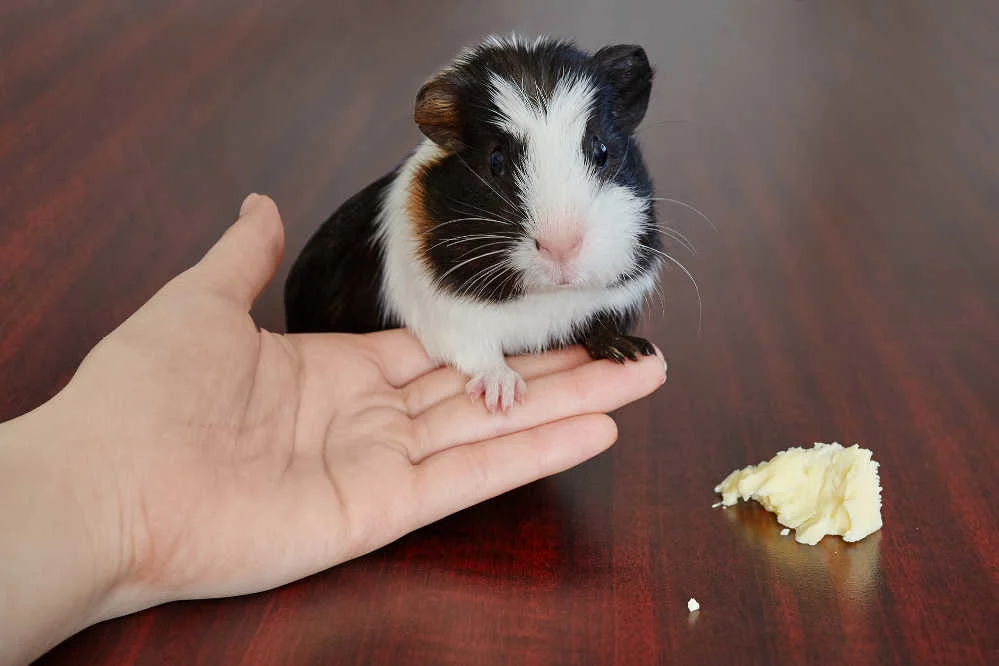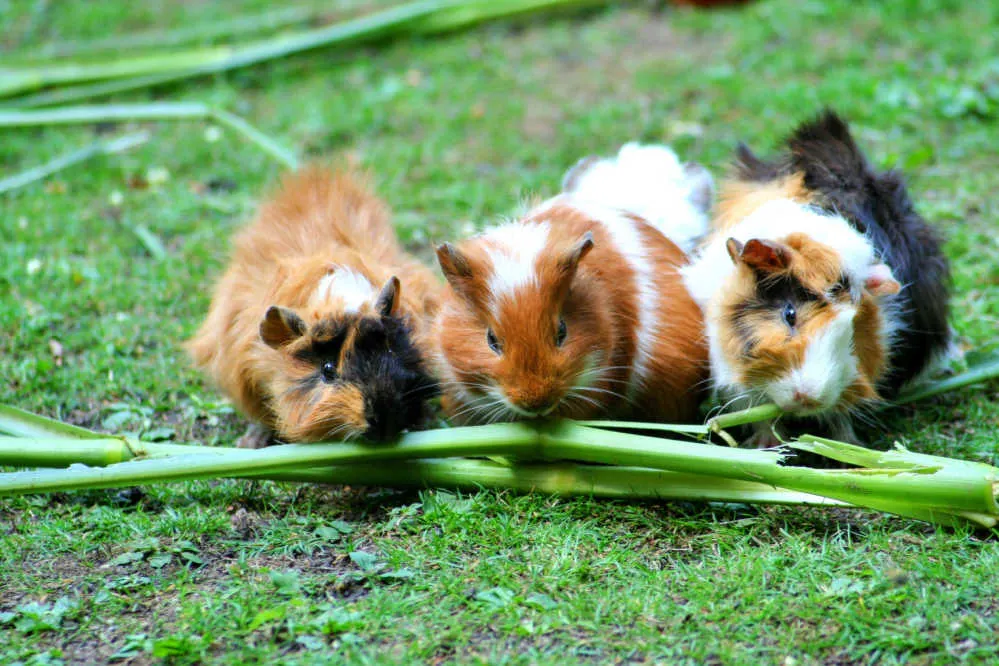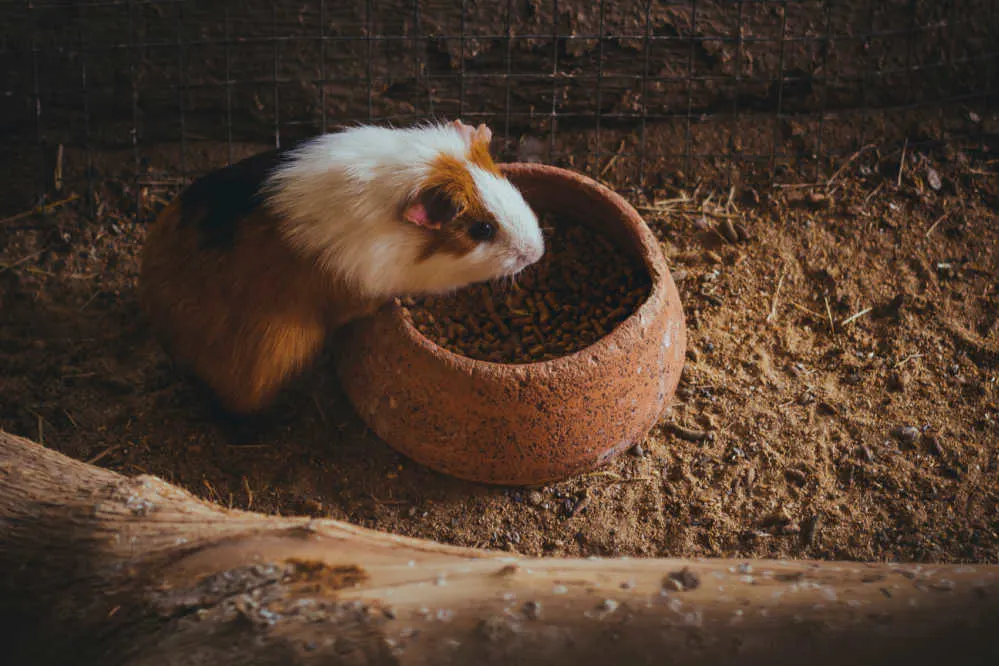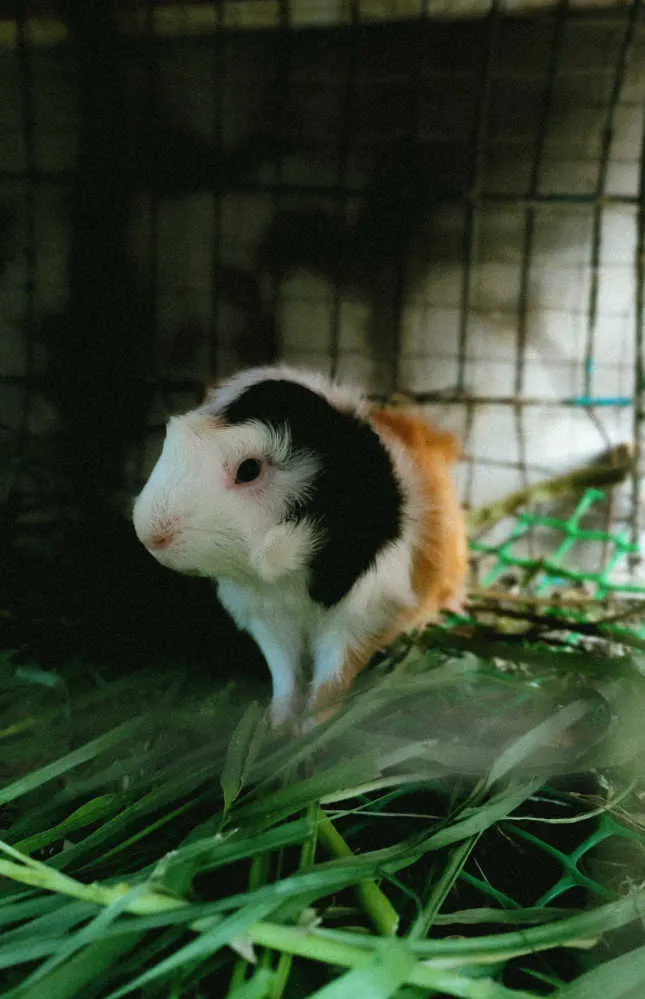It’s not from Guinea, and it’s not a pig, but it is adorable. The American guinea pig (also known as Cavia Porcellus) is probably the domesticated guinea pig we are most familiar with. They’re the most common shorthair breed, and their laidback, friendly nature makes them winners as cuddly, interactive pets.
American Guinea Pigs are also one of the healthier breeds with a long life span, so these cute critters are a natural choice for novice and experienced guinea pig owners alike.
They’re also the breed you probably think of with their short coats and range of different colors, from beige and tortoiseshell to black and white.

But how big do they grow, exactly? When space is limited, a guinea pig’s full size is a pretty important factor to take into consideration.
Without further ado, let’s jump into all aspects of the American guinea pig’s size.
Average American guinea pig size: birth to adulthood
American guinea pigs are a cuddly joy, but they’re not the new kid on the block.
Before you get a pet, one of the important factors to know is what size they’ll likely turn out to be. Size influences a few things you’ll need to buy for them, from accessories to the amount of bedding and food.
The size of guinea pig breeds can vary from eight to twelve inches (20.3 – 30.5 cm), although the American breed tends to come in a little smaller overall at eight to nine inches (20.3 – 22.8 cm). There are always outliers that can grow bigger than the average scope of their breed, and some American piggies have been known to reach as much as 12 inches (30.5 cm).
When it comes to size, genetics play a large factor. But in most circumstances, diet and lifestyle contribute a lot to the ultimate size of your piggy as well. One that has ideal nutrition and health from a young age will have a higher potential for larger growth as opposed to one that is lacking in dietary necessities or is sickly.
Birth
Baby guinea pigs typically start out at a mere three to four inches (7.6 – 10 cm) long and weigh just three and a half ounces, but you can expect some natural variation in the size of the babies in a litter. This is mostly dependent on the number of little ones the mom gives birth to.
The more pups in her uterus, the less space and greater sharing of all-important nutrients that determine overall growth and health. Therefore the larger the litter, the smaller the pups. While the size of the litter can vary from one to eight with 2-4 being the norm.
Newborn guinea pigs aren’t the wiggling helpless pink things you might imagine. They already have hair and can see and run. Within two days, they’re able to start nibbling at solid food such as moistened pellets already, but they will nurse from their mother for the first three weeks by preference.
Adolescence
By eight weeks old, the young guinea pigs have doubled in size and will have completed a fair amount of their total growth. You can expect them to be six to eight inches (15.2 – 20.3 cm) long at this point.
At the sixteen-week mark, they won’t quite have doubled again, but they’ll have grown further to about eight to ten inches (20.3 – 25.4 cm).
Some don’t grow beyond the eight-inch (20.3 cm) point, especially with the American breed, so it is possible for them to reach their peak size early in life. It is around this three to four-month mark, or earlier, that they reach sexual maturity, too.
Maturity
Guinea pigs are considered adults from the age of six months, but they only reach their full-grown size by the age of 14 months. There is a possibility that they may grow a tiny bit more afterwards, but whatever size your piggy is at this stage of their lives, that’s likely as big as it’ll ever get.

They can be anywhere between eight to twelve inches (20.3 – 30.5 cm) at this point, though the larger size is rare in this breed.
Does sex influence the size of the guinea pig?
When deciding on which sex you would prefer your guinea pig to be, numerous factors come into play. It could be your personal preference for female or male, your desire (or lack thereof) to breed, or it could come down to a particular piggy with a coat too beautiful to let go.
Size isn’t usually a factor when choosing between getting a male or female guinea pig, as people generally assume there isn’t a difference. However, there is.

Just like with many other pets, the male tends to be larger than the female of the same breed. This is how many breeders first estimate the sex of their baby cavies, as the difference is noticeable by the time they’re three weeks old.
Female American guinea pigs size
Female guinea pigs (sows) are the smaller sex and also the lighter of the two. They tend to grow as big as eight to ten inches (20.3 – 25.4 cm), with ten inches (25.4 cm) as the maximum atypical size and eight to nine inches (20.3 – 22.8 cm) being more common. They’ll weigh around one and a half to two pounds (0.68 – 0.9 kgs) when fully grown.
Male American guinea pigs size
Male guinea pigs (boars) are typically longer and heavier than their female counterparts. While they mostly tend to be a smaller nine to ten inches (22.8 – 25.4 cm), your piggy only has the potential of growing to the breed’s maximum size of 12 inches (30.5 cm) if it’s male. They’ll weigh between two to two and a half pounds (0.9 – 1.13 kgs), depending on their size.
Are different breeds of guinea pigs different sizes?
There are 13 officially recognized breeds by the American Cavy Breeders Association, and the American guinea pig is one of the oldest. Its domestication dates back to about 5,000 B.C. in the Andes Mountains.
With 12 other official breeds that have evolved in various ways over the centuries, the short answer is yes; breeds can differ in size. Part of what differentiates a breed is not only its coat and figure but its size as well.
There isn’t generally a huge size difference when it comes to guinea pig breeds, though — they tend to vary by a few inches rather than giant leaps in size difference. 12 inches (30.5 cm) is a very standard size for guinea pigs across all breeds, though some can be larger or smaller.
Abyssinian guinea pigs, as an example, tend to be on a smaller scale of eight to ten inches (20.3 – 25.4 cm) along with the American guinea pig. Although the American is usually the smaller of the two at eight to nine inches (20.3 – 22.8 cm) typically.
The largest of them all, the Rex guinea pig, grows to a whopping 17 inches (43.2 cm) — truly the king of all guinea pigs. With its dense wavy coat and a similar look to the Teddy guinea pig, it’s a giant amongst its own kind.
What cage size do I need?
When you take other small adorable rodents like mice, rats, and hamsters into account, guinea pigs are on the larger side by comparison. While they may not need the same exercise as a dog, or require the roaming abilities of a cat, they do need enough space to live a comfortable and healthy life.
It may not seem that important at a glance, but cage size matters. A lot. If your guinea pig is in a cage that’s too small for its needs, it’s far more likely to become bored, develop all manners of health problems, and be dirtier in general.

You’ll save yourself a lot of money in vet bills if you splurge a little on a bigger guinea pig cage right from the start. Plus, you’ll have a happier pet, which is what all pet owners really want.
Pet store cages
Some of the cages offered at pet stores that claim they are specifically for guinea pigs are, in fact, not large enough for these cute critters. They’re curious animals and fairly active. So enriching their lives by giving them exploration space is important to a high quality of life. When it comes to cages for your guinea pig, we recommend the following.
How to choose the perfect cage
They need space to wander and forage and, ideally, separate sections of their guinea house to vary their activity space. Different areas for bedding, hay feeder, water bowl, and a bathroom area are what you want to have in mind when designing or buying the perfect cage.
You can even add another section as a playground if you really want to make your cavy happy – and weight loss or loss of appetite can show if your guinea pig is feeling unhappy and not getting enough stimulation.
While this sounds like it mostly benefits your furry friend, it also helps you with the cleaning. Ironically, it’s easier to clean a bigger cage that has different zones because guinea pigs typically like to keep things in order, so their mess will be more contained.
Naturally, the cage should be vertical to allow space for climbing up ramps and digging down into their flooring, but floor space is of the utmost importance. These little guys will spend a lot of their time simply running around, and they’ll need somewhere to do it.
Cage dimensions
When it comes to the size of guinea pig cages, the sex or breed isn’t that important. What’s most important is how many piggies you plan on having in the cage.
Guinea pigs are social animals, so they prefer to be in a herd (even if that is a herd of just two). That’s not to say they won’t be happy alone — they just enjoy the company of other guinea pigs in addition to yours.
If you have one guinea pig, then a cage size that’s 30 x 36 inches (76.2 – 91.4 cm) is decent. If you have two, a cage that’s 30 x 50 inches (76.2 – 127 cm) is better. If you want to go the extra mile and get three, then 30 x 62 inches (76.2 – 157.5 cm) is your best bet to ensure they all have the space to move around each other comfortably. This is the minimum size of the cage, bigger is always better!
Tip: If you’re battling to find the right cage, this one is an easy choice as you can simply buy more of them and interlock them to create a larger caged space for your beloved pet.
Wrap-up on American guinea pig size
American guinea pigs are the popular kids on the guinea pig scene, not only thanks to their adorable looks but their convenient sizes, and good nature, which makes them great pets.
While the size of this oldest domesticated breed of guinea pig that originated in South America can vary a little, it tends to stay on the smaller side. This makes it ideal for pet owners with limited space for cages, or those who just prefer their squeakers to be small.
Before you pick out your guinea pig and bring them home, read our guide on how to set up a guinea pig cage with fleece so that you’re fully prepared.
Steph Dyson is a travel journalist by trade but a lover of all small pets. She’s been a pet mum to everything from gerbils to guinea pigs, rabbits to hamsters, and fish to dogs of all shapes and sizes. She wants to share her years of experience with small pets and make Small Pet Guides the go-to website for pet owners seeking information and care advice.

